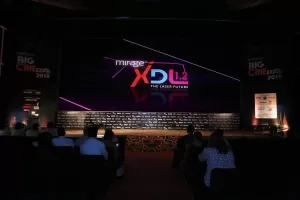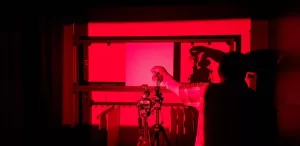White Paper Mirage XDL 1.2
Silver Screens work in a way wherein the preservation of a polarized state of projected light into discrete information streaming happens for each eye. Through the phenomenon of ‘crossed polarized filters’, the polarized nature of the projected light is adjusted so that each eye ignores the content intended for the other eye. There are many ways to deliver 3D content on to the screen, but this article will purely focus on ‘Passive Polarized Systems’.
A ‘Silver’ screen is a product designed and built to deliver minimally altered polarized light; it has been a core part of our business activity since installing our state-of-the-art coating plant in 2009. These high-gain screens would preserve the state of polarization sent through the synchronized projectors and make up for the insertion losses of the projector mounted filters, and the corresponding filters in the glasses.
LET’S OBJECTIFY THE ISSUE!
THE PROJECTOR FACTOR
- Due to the limitations of arc lamps currently used in high-end projectors, the luminance or brightness of projected cinema images is considered by many people as being too dark, especially for 3D cinema projection where a considerable amount of light is lost because of the filtering involved in creating separate views for each eye. Moreover, the output of the arc-lamp will drop considerably during its lifetime, which is itself limited to a few hundred hours leading to substantial replacement costs when operating such arc-lamp-based projectors.
- RGB Laser technology is widely considered the most promising technology for high-lumen future projection applications. These sources can combine a high lumen output with a very low étendue, which leads to high optical efficiency in the projector. The lifetime of a laser is typically one order of magnitude larger than that of arc lamps, and the output power does not degrade strongly over the laser’s lifetime.
THE SCREEN FACTOR
- Silver screens have high-gain and very narrow viewing ‘cone factors’ that help preserve the polarized state of light projected upon them.
- Due to this, they perform poorly in most measurable quality yardstick valued in projection screen applications. Insertion loss, an inevitable aspect of implementing 3D schedule, results in extremely low light levels coming off the screen.
- If a venue is to be used for 2D projection as well, without filters and glasses, the Silver screens display a distracting hot spot, inferior centre to edge uniformity, and excessive colour shift even if it is slightly off-axis.
WHAT CAUSES THIS?
- In ‘legacy’ technology silver screens, the ‘extinction ratio’ is a critical metric for a silver screen, which provides a contrast ratio between the maximum light passable through filter and glasses in an ‘open’ condition, divided by the lowest amount of light passed by the same filter regimen in a ‘closed’ condition. Using these metrics,we can understand that high-performance Silver screens can hold two channels of information at the ratio of 350:1, using quality linear polarizing filters. Circular polarization ratios tend to yield a bit lower, due to the ‘quarter-wave baseline component’. A narrow viewing cone is a crumbling side effect of a high ratio of extinction. A quality matte fabric, made with an optimum centre to edge performance, will have a viewing cone of at least 85°. Galalite manufactures this and many other high-performance matte elevated gains with a tailored off axis behaviour, teamed with viewing cones well over 65°. These appear flat with polarized light. Having stated that a screen with an excellent ratio of extinction “usually” has a viewing cone of between 14 and 24°.
- Most commercial cinema projection is designed at fairly long throws of ratio 3:1, 5:1 and higher in big houses. This helps disguise the flaws of the Silver screens since long-throw projection showcases light through an orthogonal distribution than a short-throw system. In cinemas that are often built with shorter throws, the typical Silver screens show a pronounced hot spot and the lack of centre to edge uniformity and also a colour shift mostly seen in many high gain screens. When 3D is projected on such a screen, the depth effect masks the hotspot and shows off well, till a well-lit high key shot shows up and reveals the problems. In case a high definition 2D content is shown on such a screen, the planar surface of the screen, the unkind and inaccurate colourimetric tendencies, and the polarizing beam splitting treatment of white fields are revealed. In the world of commercial cinema, the proliferation of 3D content has been extensive, with many features competing for a limited but expanding number of 3D capable theatres.
- With the introduction of RGB Laser Light Source in Projectors, the laser speckle is an unwanted by-product, especially for high gain silver screens. This pattern is a granular pattern of spots overlaid on the projected image. Speckle arises due to the quasi-random interference that is generated because of the coherent laser beam which is scattered from a projection screen that is rough on the scale of the optical wavelength. As the speckle pattern in a laser projector is usually the sum of multiple, independent speckle patterns, each of which is created by a large number of independent scattering elements, the speckle pattern is displeasing for a human observer, and therefore, it needs to be reduced to an acceptable level.
- A major technology obstacle in using lasers for projection has been the speckle noise caused by the coherent nature of the lasers.
THE BASIC SOLUTION
So, here is our solution; cut that problematic behaviour in half, thanks to the relentlessly evolving R&D. Lowering the gain of a Silver Screen seems like an easy answer, but then the crucial ratio of extinction will plummet disproportionately. The insufficient ratio of extinction results in ghosting and often a grain to the appearance of the screen. When the tipping point of functionality is reached, the screen may present an image that resembles the fog of analogue static interference, which is not acceptable. When the gain is lowered naturally, the viewing cone will widen, and the screen will start behaving more like a normal screen, better centre to edge uniformity, less hot spotting. The upside of this possibility was too enticing for Galalite’s engineers to ignore. So, they got to work to really explore how to lower the gain of a silver screen without crashing the critical ratio of extinction.
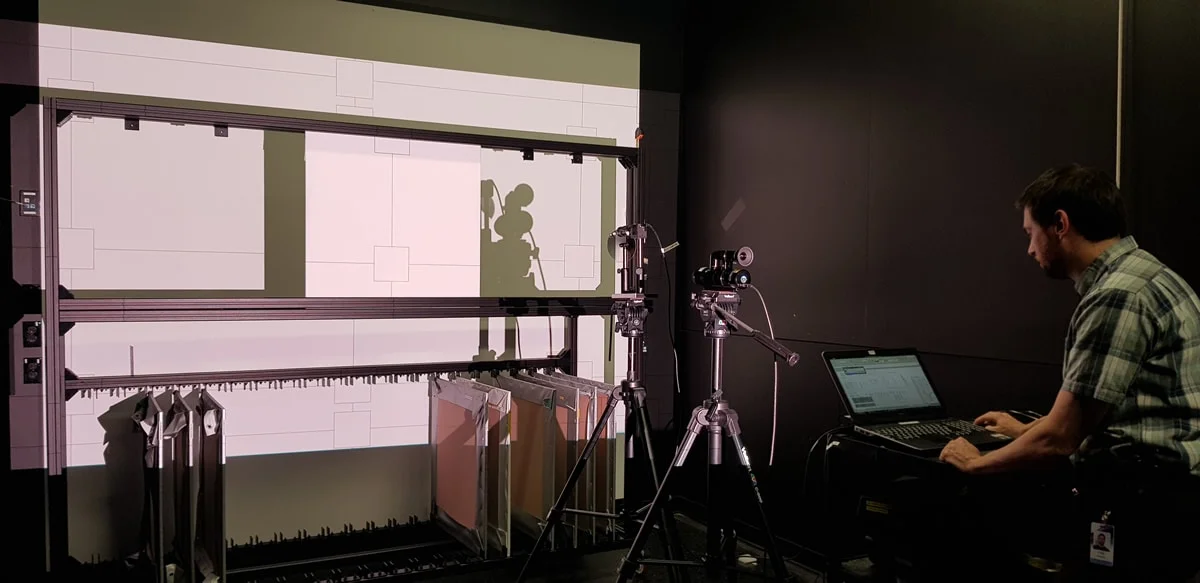
THIS IS THE THEORY AND DELIVERY OF GALALITE’S LENSRAY TECHNOLOGY WHICH LED TO THE EVOLUTION OF MIRAGE XDL 1.2.
First, we identified a speckle disturbance threshold statistically analyzing the observers’ responses for different values of the amount of speckle, which was monitored using a well-defined speckle measurement method. The analysis showed that the speckle perception of a human observer is not only dependent on the objectively measured amount of speckle, but it is also strongly influenced by the image content. The speckle disturbance limit for movies turns out to be substantially larger than that for still images and hence is easier to attain.
THERMAL IMAGERY
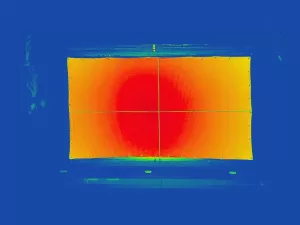
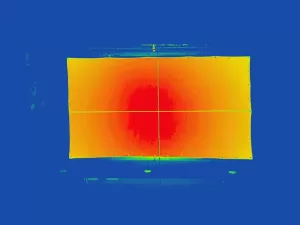
- Our R&D team is continuously quantifying, re-formulating, refining and prototyping new ways of producing Silver Screen surfaces for Passive 3D. From the method and formulation of the substrate to the formulation and application of the optical coating, every minute detail has been thought of and incorporated. This resulted in umpteen sample formulations, exploring the function and nature of the ratio of extinction and how it works on a microscopic scale. Theories and sub-theories were tested and verified under this projection.
- The geniuses at Galalite didn’t leave anything to the imagination while working checked and rechecked every minute detail to really understand how each change in formulation and each trend in the metrics affect all measurable and observable behaviours of the surface; which is why we, at Galalite, are redefining what can be done with a polarization preserving screen. With significantly wide viewing cones from the centre, Screens with Lensray Technology provide a highly improved and evolved centre to edge uniformity and yet furnish a robust ratio of extinction! This technology can offer a lot of benefits for the cinema industry. The main goal, cinema exhibitors aim to achieve is increased profitability by sustaining lower total cost of ownership, differentiation and by assuring a better and more consistent image presentation.
- The Mirage XDL with a reduced gain of 1.2, was specially crafted to reduce speckle in RGB laser projectors, the best centre to edge uniformity, excellent extinction ratio for Passive 3D, and the deepest black levels possible on a Cinema Screen. Mirage XDL 1.2 offers a brilliant movie-watching experience. It is an ideal screen for the current times when there are so many options available for discerning movie viewers since it gives an unrivalled movie viewing experience.

